
JULIA LEE BARCLAY-MORTON – YOGA, WATER AND REWRITING AUTISM
I interviewed writer Julia Lee Barclay-Morton about her experience of autism. Julia began as an experimental dramatist in New York, moving to the UK to
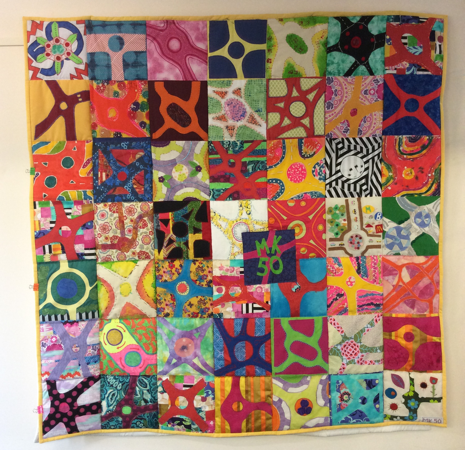
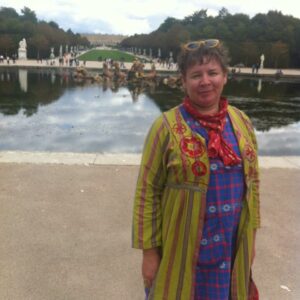
I interviewed textile artist Jane Charles, whose quilts have been chosen for major displays at the National Exhibition Centre and around Europe. Jane teaches creative textiles to adults and children and has had several major commissions, including projects for New Bradwell School, Orchard Academy and the giant-sized Wolverton Quilts.
Leslie: As a textile artist, can you describe your materials, methods and the range of artworks you produce, please? How did you first learn and develop your skills?
Jane: I’ve been working with fabrics all my adult life, I did a degree in Fashion and textiles back in the the 80’s at Leicester Polytechnic and from there worked in a number of settings including costume maker for the performance degrees at Leicester for a couple of years. Making ends meet took over my working life when I moved to London, but I think I kept up with sewing small projects and then I started making for my children 20 years ago, until they argued with what I made for them!
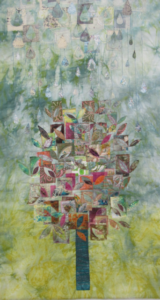
I’ve now been more inspired by Creative Textiles for the last 10 years or so and much of my work has come from trial and error, lots of research into books and blogs on the net. Creative Textiles is such a huge imaginative industry, there are no end of materials, techniques and new products to try all the time; it’s very addictive. I do have a studio space, but it’s not very specialist, just a large space in a co-operative of other artists and I’m also conscious that my students won’t have much space either so I try to keep techniques ‘kitchen friendly’ and affordable.
I do a lot of dyeing of fabrics, mainly 100% cottons with either Procion dyes or the wonderful Indigo dye. I also love block printing, so would often hand cut a block and print onto the dyed fabrics. I then machine embroider more thread sketching or hand embroider detail.
Leslie: Where do your ideas come from and who are the creative figures who have inspired you?
Jane: I’m a great advocate of Pinterest and follow lots of different artists, not always textile, many printers, ceramicists and paper artists. I’ve got dozens of boards and always look back into them for new projects that come my way. My teaching often inspires me, so if we are doing a particular technique but I’ve not got very good examples of it, I’ll design and create something to show the technique off to its best potential. This sometimes takes me out of my usual working practice, but it’s always a good journey.

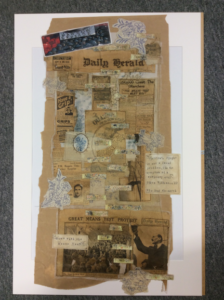 I’m also inspired by things I find out and about. For example we were having some windows replaced in our Victorian terrace house and the original frames were still in the walls, there was some newspaper stuffed in the frames (not sure why!) so I scouted around for as much as I could find, seeing that the date was 1933 and saved it all in a bag. A few months later, I pulled them all out and pieced them together, it was the front page of the Daily Herald – a controversial paper at the time – and the news was about the Jarrow Crusade. In absolute desperation, 200 men from Jarrow in the North East of England walked 300 miles to London to protest at the lack of jobs and lack of any support from the Welfare for them. I have relatives from the North East, so it was a poignant find and I set about putting it together to make a textile piece. I also added embroidery paper patterns that were current at the time and researched the route the men took.
I’m also inspired by things I find out and about. For example we were having some windows replaced in our Victorian terrace house and the original frames were still in the walls, there was some newspaper stuffed in the frames (not sure why!) so I scouted around for as much as I could find, seeing that the date was 1933 and saved it all in a bag. A few months later, I pulled them all out and pieced them together, it was the front page of the Daily Herald – a controversial paper at the time – and the news was about the Jarrow Crusade. In absolute desperation, 200 men from Jarrow in the North East of England walked 300 miles to London to protest at the lack of jobs and lack of any support from the Welfare for them. I have relatives from the North East, so it was a poignant find and I set about putting it together to make a textile piece. I also added embroidery paper patterns that were current at the time and researched the route the men took.
Leslie: Which projects with adults and schoolchildren have you learned the most from?
Jane: Much of my paid work is with adults or children; my own work I often just do for pleasure with the vague hope that someone might buy it one day! Working with adults is often about ‘me time’ and new adventures for adults who’ve never been given the opportunity to make before. They might be able to knit or stitch clothes, but dyeing and printing and Creative Textiles opens up whole new interests and opportunities for them – it’s great! I often create an exhibition around themes and the work we have been doing, and they are so proud to be part of this and to have their work appreciated.

2017 was an important year for Milton Keynes, celebrating its 50th Birthday and I organized a great quilt challenge to make 50 images of roundabouts in ‘popping’ art colours. Many of my past students made some blocks and some groups around Milton Keynes who support people living with challenging circumstances, so it was a wonderful celebration of textiles and Milton Keynes all rolled into one bold quilt.
Children these days are not so different, much of the art and creative time in schools has been lost so it’s lovely to be able to go into a school and work with every child, show them things and create magic with colour and pattern. When we are done, I put all the work together and it’s displayed in the school, we have made history that will stay on the walls for years to come!
Leslie: What have been the most challenging and rewarding moments for you as an artist?

Jane: I was lucky to be chosen for a large commission locally earlier this year, creating six huge quilts that hang in the Old Bath House community center in Wolverton. I am usually asked to do these big quilts with a group of people so techniques are very different and there is a lot of stitching small bits of fabric together. With this project there was no obligation to work with groups, so I took the opportunity to make ‘whole cloth’ quilts all by myself. There were lots of things to consider, the theme was to celebrate Wolverton and its community. It was the ‘first railway town’ and housed the Royal train for many years and now has lots of enterprising people and projects. I wanted to include as many things as I could in the project, the previous quilts had been up for over 20 years and although past their best, were popular with the locals. This drastic change was controversial. Each quilt is 2.5m deep and varies in width as you can see. They are so huge I didn’t know if they would hang properly until they were hanging in the space – no pressure! And it was a one-hit hanging evening, the floor was being polished the next day and there was no opportunity to hang them again that week. I was so relieved when they went up and the Old Bath House group were delighted. I hope they will be there for 20 years again, I’m proud to have contributed to some local history.
Leslie: If you had to choose your own top five artworks, which would they be, and why?

Jane: Looking around the house, I’ve had this print on the wall for a number of years. I love the simplistic lines of Joseph Crawhall’s work. He was one of the Glasgow Boys at the turn of the last century and we saw some of their work at the Burrell Collection in Glasgow over 20 years ago.
I remember always loving the image Carnation, Lily, Lily, Rose. John Singer Sargent 1885-6 from an early age and probably studying Art History at collage – beautiful light and atmosphere.
I bought a postcard of Women drinking beer by Edouard Manet in the 80’s on another art trip to London. It reminded me of my friend Fran and our taste for drinking beer. Funnily enough I see it’s also in the Burrell collection in Glasgow, but I must have bought the postcard and not seen the work. I didn’t go to Glasgow until the 1990’s. Unless it was at an exhibition in London.
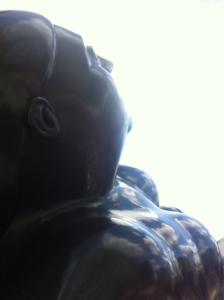
We lived in London for around 12 years, very near Liverpool Street station and Spittalfields (before it was trendy) This is my favorite sculpture from that area, she is so huge and bold but is still dwarfed by the buildings and square she lies in behind the station. Popping along for a visit last year, I took this photo with some surreal clouds reflected in her bosoms, fabulous addition!
And finally, I find the work of Edward Bawden the mid-century printmaker very inspiring. Whatever I see of his really. Fabulous simple lines and colour. Peacock and Magpie print
Leslie: What effects are you trying to achieve as a textile artist?
Jane: Looking at my favorite painting choices and thinking about my own work, what I like is the textures and colours of an image highlighted by fine ‘drawing’ detail. This often features in my projects, a mass of colour and shapes with free-motion stitching and collage or drawings that pull it all together.
Working with textiles is very addictive, there are so many possibilities, techniques and things to try, it’s a wonderful medium to work in. Sometimes it’s spontaneous and dramatic, sometimes very thoughtful and measured.
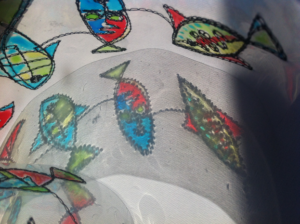 I’m not a super groundbreaker, but last year I did experiment with trying to emulate the reflections of stained glass with textiles. Stitching directly onto acetate and then colouring in the sections of my images. You can see with this photograph, the stitched fish are on the right and their wonderful shadows are in the middle of the image. I should probably take this work further, I did enjoy the process and the magic of the colourful shadows.
I’m not a super groundbreaker, but last year I did experiment with trying to emulate the reflections of stained glass with textiles. Stitching directly onto acetate and then colouring in the sections of my images. You can see with this photograph, the stitched fish are on the right and their wonderful shadows are in the middle of the image. I should probably take this work further, I did enjoy the process and the magic of the colourful shadows.
Leslie: If you have an emotional driver to your artistic work, what is it please?
Jane: I don’t think I could do anything else or be me if I didn’t make textiles.
My teaching and therefore sharing of skills, inspiration and passion for crafting pays me some money, not very much to be honest, but occasionally I am lucky to get a commission or larger project which contributes to the family pot.
I would never hand over work or sell work that I was not completely happy with, that would not be good for business or the image of handmade work. My customers should be delighted and happy to recommend me to others.
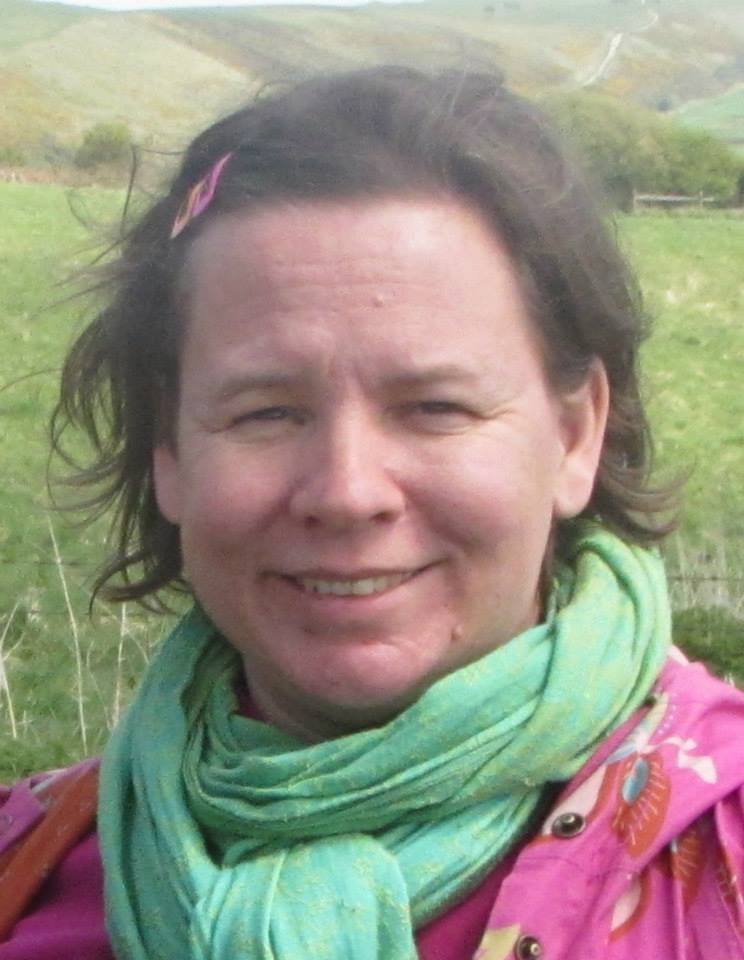
To see more of Jane’s work, click here.
On April 9th I ask actor, writer, artist and comedian Cy Henty about his stage career – including touring with Russell Brand and a run at The Pleasance Theatre, Edinburgh.
ABOUT LESLIE TATE’S BOOKS:

I interviewed writer Julia Lee Barclay-Morton about her experience of autism. Julia began as an experimental dramatist in New York, moving to the UK to

I interviewed Gillean McDougall from Glasgow, who edited the collaborative projects Honest Error (on Charles Rennie Mackintosh and his wife Margaret Macdonald) and Writing the

I interviewed French writer Delphine de Vigan, whose book, No et moi, won the prestigious Prix des libraires. Other books of hers have won a clutch

I interviewed Joanne Limburg whose poetry collection Feminismo was shortlisted for the Forward Prize for Best First Collection; another collection, Paraphernalia, was a Poetry Book Society Recommendation. Joanne

I interviewed Katherine Magnoli about The Adventures of KatGirl, her book about a wheelchair heroine, and Katherine’s journey from low self-esteem into authorial/radio success and
| Cookie | Duration | Description |
|---|---|---|
| cookielawinfo-checkbox-analytics | 11 months | This cookie is set by GDPR Cookie Consent plugin. The cookie is used to store the user consent for the cookies in the category "Analytics". |
| cookielawinfo-checkbox-functional | 11 months | The cookie is set by GDPR cookie consent to record the user consent for the cookies in the category "Functional". |
| cookielawinfo-checkbox-necessary | 11 months | This cookie is set by GDPR Cookie Consent plugin. The cookies is used to store the user consent for the cookies in the category "Necessary". |
| cookielawinfo-checkbox-others | 11 months | This cookie is set by GDPR Cookie Consent plugin. The cookie is used to store the user consent for the cookies in the category "Other. |
| cookielawinfo-checkbox-performance | 11 months | This cookie is set by GDPR Cookie Consent plugin. The cookie is used to store the user consent for the cookies in the category "Performance". |
| viewed_cookie_policy | 11 months | The cookie is set by the GDPR Cookie Consent plugin and is used to store whether or not user has consented to the use of cookies. It does not store any personal data. |
2 responses
Fabulous article, Leslie and Jane. I saw some really beautiful quilts at Pashley Gardens when we were in the UK last August. I love the support for artists and writers you find in the UK. All of these quilts are incredible.
Yes, Jane is a real expert. Thanks for reading about her!